人教选择性必修三Unit 2 高考真题练(含解析)
文档属性
| 名称 | 人教选择性必修三Unit 2 高考真题练(含解析) | 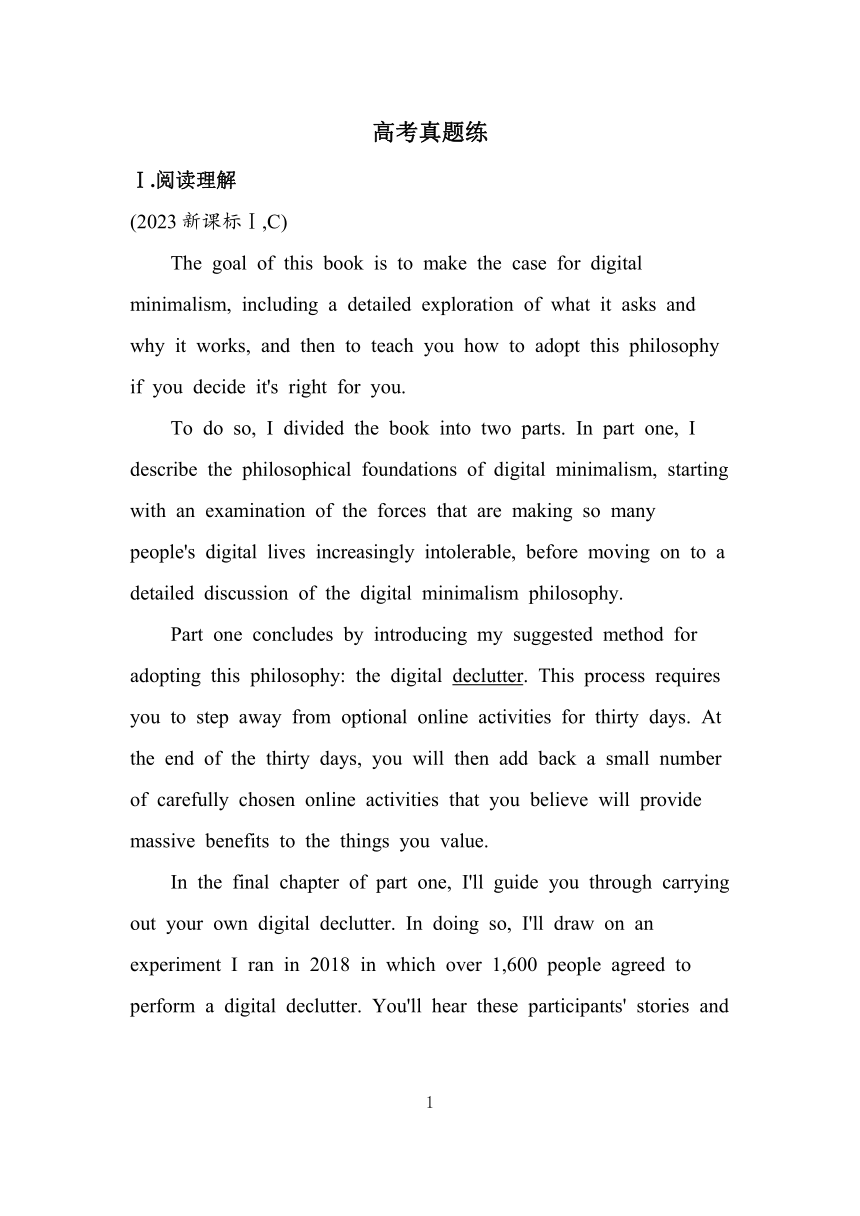 | |
| 格式 | docx | ||
| 文件大小 | 31.3KB | ||
| 资源类型 | 试卷 | ||
| 版本资源 | 人教版(2019) | ||
| 科目 | 英语 | ||
| 更新时间 | 2025-07-09 08:39:07 | ||
图片预览

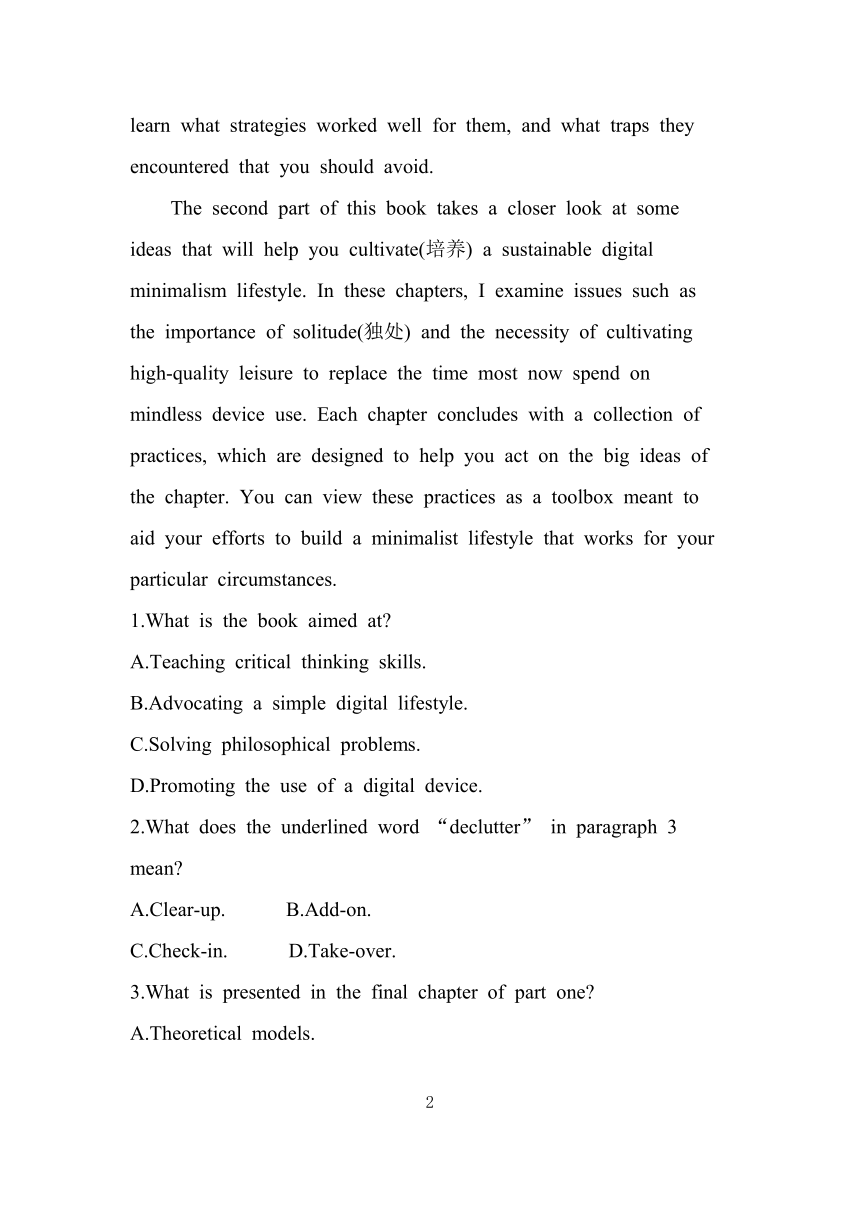
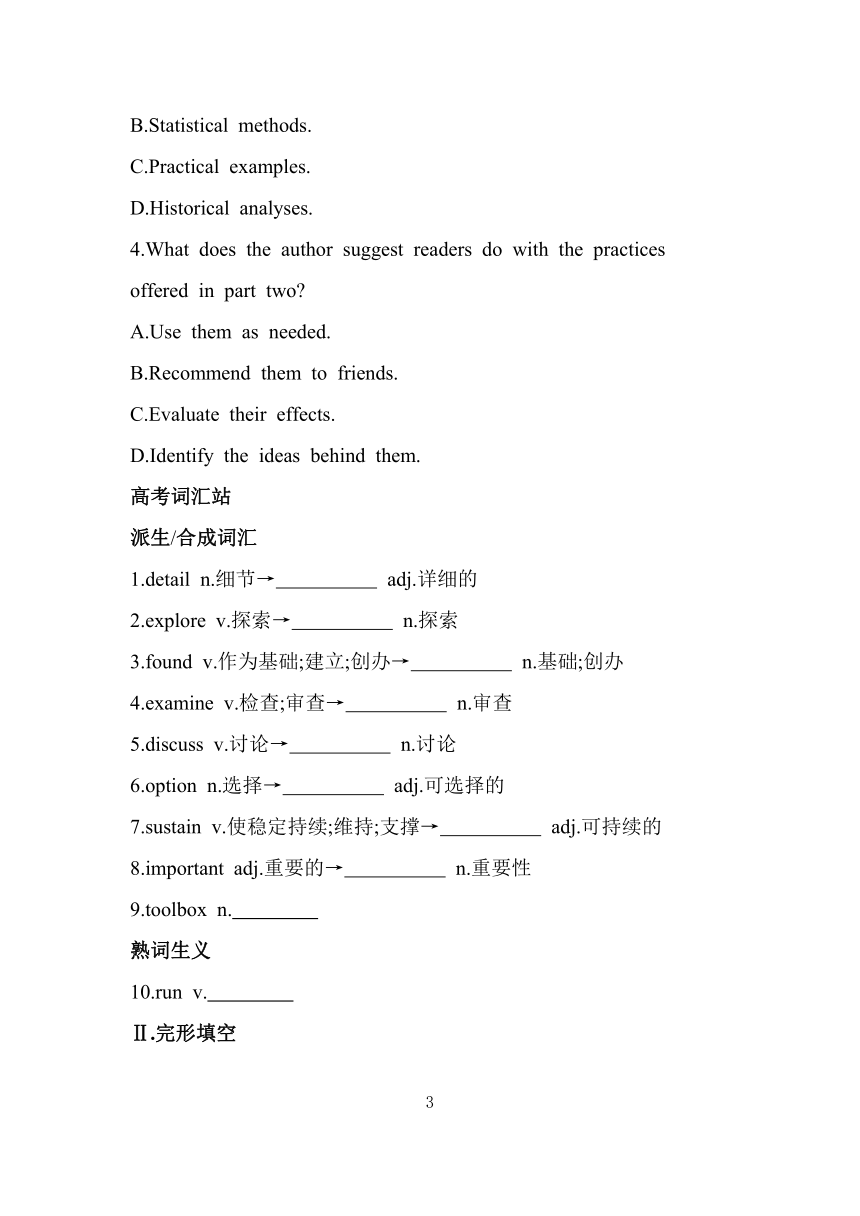
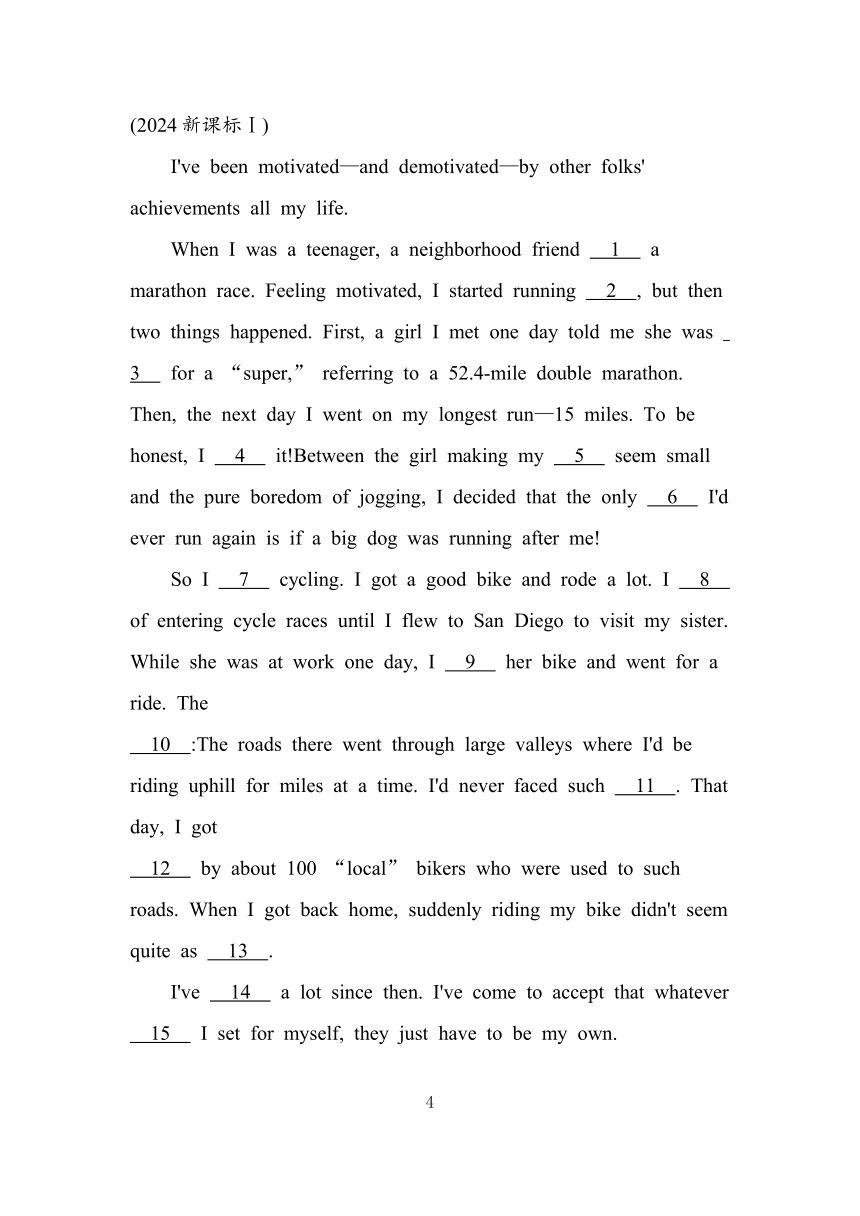
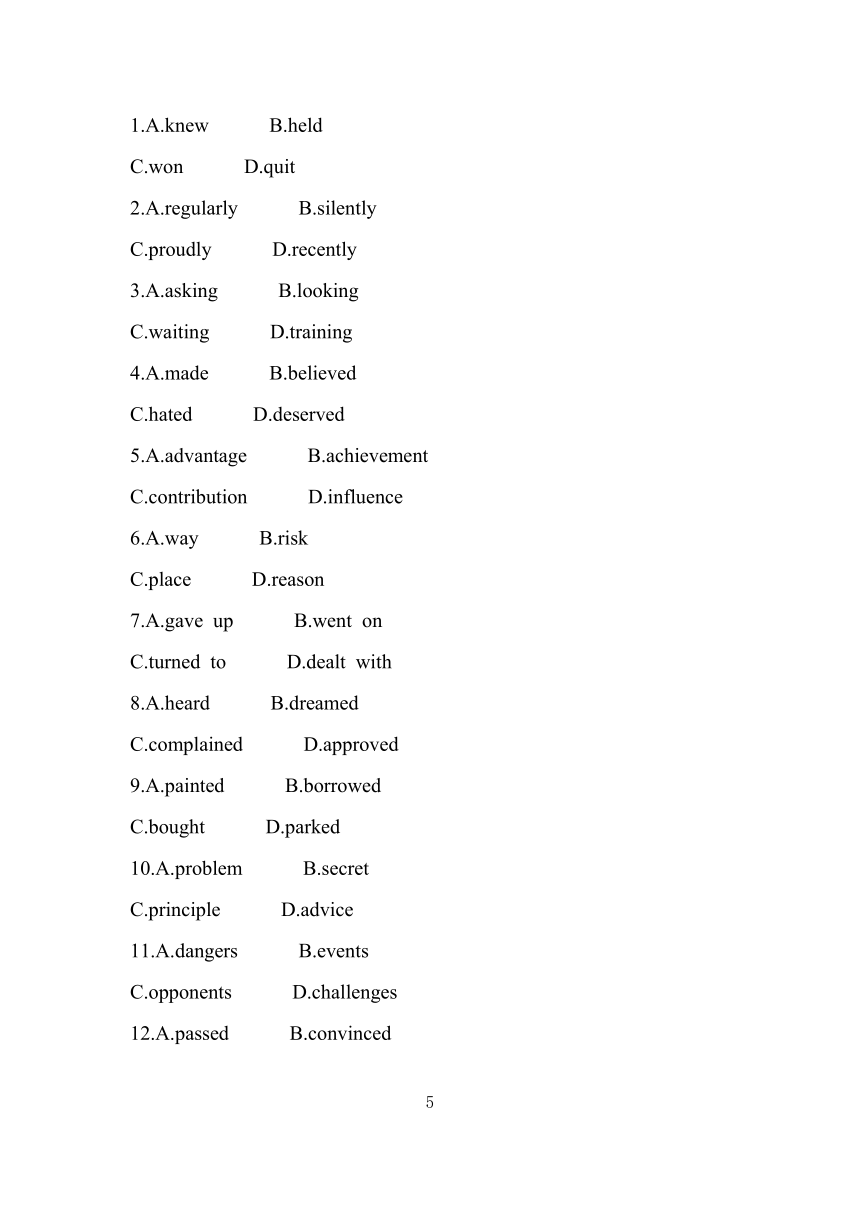
文档简介
高考真题练
Ⅰ.阅读理解
(2023新课标Ⅰ,C)
The goal of this book is to make the case for digital minimalism, including a detailed exploration of what it asks and why it works, and then to teach you how to adopt this philosophy if you decide it's right for you.
To do so, I divided the book into two parts. In part one, I describe the philosophical foundations of digital minimalism, starting with an examination of the forces that are making so many people's digital lives increasingly intolerable, before moving on to a detailed discussion of the digital minimalism philosophy.
Part one concludes by introducing my suggested method for adopting this philosophy: the digital declutter. This process requires you to step away from optional online activities for thirty days. At the end of the thirty days, you will then add back a small number of carefully chosen online activities that you believe will provide massive benefits to the things you value.
In the final chapter of part one, I'll guide you through carrying out your own digital declutter. In doing so, I'll draw on an experiment I ran in 2018 in which over 1,600 people agreed to perform a digital declutter. You'll hear these participants' stories and learn what strategies worked well for them, and what traps they encountered that you should avoid.
The second part of this book takes a closer look at some ideas that will help you cultivate(培养) a sustainable digital minimalism lifestyle. In these chapters, I examine issues such as the importance of solitude(独处) and the necessity of cultivating high-quality leisure to replace the time most now spend on mindless device use. Each chapter concludes with a collection of practices, which are designed to help you act on the big ideas of the chapter. You can view these practices as a toolbox meant to aid your efforts to build a minimalist lifestyle that works for your particular circumstances.
1.What is the book aimed at
A.Teaching critical thinking skills.
B.Advocating a simple digital lifestyle.
C.Solving philosophical problems.
D.Promoting the use of a digital device.
2.What does the underlined word “declutter” in paragraph 3 mean
A.Clear-up. B.Add-on.
C.Check-in. D.Take-over.
3.What is presented in the final chapter of part one
A.Theoretical models.
B.Statistical methods.
C.Practical examples.
D.Historical analyses.
4.What does the author suggest readers do with the practices offered in part two
A.Use them as needed.
B.Recommend them to friends.
C.Evaluate their effects.
D.Identify the ideas behind them.
高考词汇站
派生/合成词汇
1.detail n.细节→ adj.详细的
2.explore v.探索→ n.探索
3.found v.作为基础;建立;创办→ n.基础;创办
4.examine v.检查;审查→ n.审查
5.discuss v.讨论→ n.讨论
6.option n.选择→ adj.可选择的
7.sustain v.使稳定持续;维持;支撑→ adj.可持续的
8.important adj.重要的→ n.重要性
9.toolbox n.
熟词生义
10.run v.
Ⅱ.完形填空
(2024新课标Ⅰ)
I've been motivated—and demotivated—by other folks' achievements all my life.
When I was a teenager, a neighborhood friend 1 a marathon race. Feeling motivated, I started running 2 , but then two things happened. First, a girl I met one day told me she was 3 for a “super,” referring to a 52.4-mile double marathon. Then, the next day I went on my longest run—15 miles. To be honest, I 4 it!Between the girl making my 5 seem small and the pure boredom of jogging, I decided that the only 6 I'd ever run again is if a big dog was running after me!
So I 7 cycling. I got a good bike and rode a lot. I 8 of entering cycle races until I flew to San Diego to visit my sister. While she was at work one day, I 9 her bike and went for a ride. The
10 :The roads there went through large valleys where I'd be riding uphill for miles at a time. I'd never faced such 11 . That day, I got
12 by about 100 “local” bikers who were used to such roads. When I got back home, suddenly riding my bike didn't seem quite as 13 .
I've 14 a lot since then. I've come to accept that whatever 15 I set for myself, they just have to be my own.
1.A.knew B.held
C.won D.quit
2.A.regularly B.silently
C.proudly D.recently
3.A.asking B.looking
C.waiting D.training
4.A.made B.believed
C.hated D.deserved
5.A.advantage B.achievement
C.contribution D.influence
6.A.way B.risk
C.place D.reason
7.A.gave up B.went on
C.turned to D.dealt with
8.A.heard B.dreamed
C.complained D.approved
9.A.painted B.borrowed
C.bought D.parked
10.A.problem B.secret
C.principle D.advice
11.A.dangers B.events
C.opponents D.challenges
12.A.passed B.convinced
C.admired D.stopped
13.A.reliable B.convenient
C.familiar D.appealing
14.A.traveled B.matured
C.missed D.worried
15.A.limits B.dates
C.goals D.tests
高考词汇站
派生/合成词汇
1.motivate v.使有动机,激发→ adj.有积极性的
2.achieve v.实现→ n.成就
3.bore v.使厌烦→ n.厌烦
4.regular adj.定期的;有规律的→ adv.定期地;有规律地
5.rely v.依赖→ adj.可信赖的
6.convenience n.便利→ adj.便利的
7.appeal v.有吸引力;恳求→ adj.有吸引力的;恳求的
8.uphill adv.
答案与分层梯度式解析
UNIT 2 HEALTHY LIFESTYLE
高考真题练
Ⅰ.◎语篇解读 本文是说明文,主要介绍了一本书,其中包括这本书的组成部分以及各部分的内容。读这本书可以帮读者践行数字极简主义的生活方式。
1.B 细节理解题。根据题干关键词aimed at可定位到第一段中的goal。根据第一段内容可知,这本书的目的是解释数字极简主义(make the case for digital minimalism),包括详细探索它的要求是什么和它为什么有效,并且教你如何采用这种生活方式。其中teach you how to adopt和digital minimalism分别与B项中的Advocating和simple digital lifestyle相呼应。故选B(倡导一种简单的数字生活方式)。A项意为“教授批判性思维技巧”,C项意为“解决哲学问题”,D项意为“推广数码设备的使用”。
2.A 词义猜测题。根据画线词所在句中的冒号可知,the digital declutter就是“my suggested method for adoptingthis philosophy”。this philosophy指的是数字极简主义(digital minimalism),那么采用这种生活方式的方法也应该与极简有关。后句是对the digital declutter的具体阐述——30天不参加非强制的线上活动,30天结束的时候,选择参加少量你认为会给你所看重的东西带来巨大好处的线上活动。言外之意就是,对数字活动进行清理(Clear-up)。故选A。
3.C 细节理解题。根据题干关键词the final chapter of part one可定位到第四段。在第一部分的最后一个章节,作者会分享1,600多名参与者的故事以及具体的策略,同时也会提醒大家可能遇到的陷阱。这些都是真实的事例(Practical examples)。故选C。A项意为“理论模型”,B项意为“统计方法”,D项意为“历史分析”。
4.A 细节理解题。本题问的是“对于第二部分提供的具体做法,作者建议读者做什么 ”。根据题干关键词the practices offered in part two可定位到最后一段最后两句。核心的内容是“view these practices as a toolbox meant to aid your efforts to build a minimalist lifestyle”,即把这些具体做法当成一个工具箱。故选A。
【高考词汇站】 1.detailed 2.exploration 3.foundation
4.examination 5.discussion 6.optional 7.sustainable
8.importance 9.工具箱 10.进行;运行;组织;经营
长难句
原句 The goal of this book is to make the case for digital minimalism, including a detailed exploration of what it asks and why it works, and then to teach you how to adopt this philosophy if you decide it's right for you.
分析 本句为主从复合句。第二个and连接两个并列的动词不定式短语作表语;在第一个表语中,what it asks和why it works是介词of后两个并列的宾语从句;在第二个表语中,how to adopt this philosophy if you decide it's right for you是“疑问词+不定式”结构作teach的宾语,其中包含if引导的条件状语从句。
译文 本书的目标是解释数字极简主义,包括详细探索它的要求是什么和它为什么有效,如果你断定它适合你的话,本书会教你如何采用这种生活方式。
Ⅱ.◎语篇解读 本文是一篇记叙文。文章主要讲述了作者在成长过程中受到别人的启发和鼓舞,不断仿效别人但终因不符合自己实际情况而中途放弃的故事,由此告诉我们要设立符合自身实际的人生目标。
1.C 考查动词。根据下文Feeling motivated,I started running可知作者受到邻居朋友赢得一场比赛的启发。 A.知道;B.举办;D.放弃。故选C。
2.A 考查副词。作者受到鼓舞之后,也开始定期跑步。 B.默默地;C.骄傲地;D.近期。故选A。
3.D 考查动词。有一天作者遇到一个女孩,她告诉作者她正在为一个超级马拉松比赛训练。 A.要求;B.看;C.等待。故选D。
4.C 考查动词。根据前面的To be honest以及下文的the pure boredom of jogging可以判断这里需要用一个消极意义的词(hate憎恶)。A.使成功;B.相信;D.值得。故选C。
5.B 考查名词。根据上文女孩跑超级马拉松可知这显得作者的成就很渺小。A.优势;C.贡献;D.影响。故选B。
6.D 考查名词。作者决定再次跑步的原因是如果一只大狗在其后面追。言外之意,作者以后就不再愿意跑步了。A.方式,方法;B.冒险;C.地方。故选D。
7.C 考查动词短语。turn to指的是“转向”,此处指转向另外一项运动。 A.放弃;B.继续;D.处理。故选C。
8.B 考查动词。dream of doing sth.指的是梦想做某事。A.听说;C.抱怨;D.同意。故选B。
9.B 考查动词。姐姐有一天工作的时候,作者借了她的自行车。A.粉刷;C.买;D.停车。故选B。
10.A 考查名词。根据冒号以及下文说那里的路需要经过一些大的山谷,而这些山谷需要骑车上坡几英里可知,这是作者面临的问题。B.秘密;C.准则;D.建议。故选A。
11.D 考查名词。句意:我从来没有面对过这样的挑战。A.危险;B.事件;C.对手。故选D。
12.A 考查动词。根据下文可知作者被大约100个“当地的”自行车骑手超过,而这些自行车骑手已经习惯了这样的山路。get passed by意为“被超过”。B.说服;C.钦佩;D.停下。故选A。
13.D 考查形容词。根据上文可知作者遇到了挫折,当作者到家的时候,骑自行车突然变得似乎不那么有吸引力了。A.可依赖的;B.方便的,便捷的;C.熟悉的。故选D。
14.B 考查动词。句意:从那之后我成熟了很多。 A.旅行;C.错过;D.担忧。故选B。
15.C 考查名词。set goals设立目标。句意:我开始接受不管我为自己设立了什么样的目标,这些目标必须是我自己的。A.局限;B.日期;D.考验。故选C。
【高考词汇站】 1.motivated 2.achievement
3.boredom 4.regularly 5.reliable 6.convenient
7.appealing 8.上山地;上坡地
11
Ⅰ.阅读理解
(2023新课标Ⅰ,C)
The goal of this book is to make the case for digital minimalism, including a detailed exploration of what it asks and why it works, and then to teach you how to adopt this philosophy if you decide it's right for you.
To do so, I divided the book into two parts. In part one, I describe the philosophical foundations of digital minimalism, starting with an examination of the forces that are making so many people's digital lives increasingly intolerable, before moving on to a detailed discussion of the digital minimalism philosophy.
Part one concludes by introducing my suggested method for adopting this philosophy: the digital declutter. This process requires you to step away from optional online activities for thirty days. At the end of the thirty days, you will then add back a small number of carefully chosen online activities that you believe will provide massive benefits to the things you value.
In the final chapter of part one, I'll guide you through carrying out your own digital declutter. In doing so, I'll draw on an experiment I ran in 2018 in which over 1,600 people agreed to perform a digital declutter. You'll hear these participants' stories and learn what strategies worked well for them, and what traps they encountered that you should avoid.
The second part of this book takes a closer look at some ideas that will help you cultivate(培养) a sustainable digital minimalism lifestyle. In these chapters, I examine issues such as the importance of solitude(独处) and the necessity of cultivating high-quality leisure to replace the time most now spend on mindless device use. Each chapter concludes with a collection of practices, which are designed to help you act on the big ideas of the chapter. You can view these practices as a toolbox meant to aid your efforts to build a minimalist lifestyle that works for your particular circumstances.
1.What is the book aimed at
A.Teaching critical thinking skills.
B.Advocating a simple digital lifestyle.
C.Solving philosophical problems.
D.Promoting the use of a digital device.
2.What does the underlined word “declutter” in paragraph 3 mean
A.Clear-up. B.Add-on.
C.Check-in. D.Take-over.
3.What is presented in the final chapter of part one
A.Theoretical models.
B.Statistical methods.
C.Practical examples.
D.Historical analyses.
4.What does the author suggest readers do with the practices offered in part two
A.Use them as needed.
B.Recommend them to friends.
C.Evaluate their effects.
D.Identify the ideas behind them.
高考词汇站
派生/合成词汇
1.detail n.细节→ adj.详细的
2.explore v.探索→ n.探索
3.found v.作为基础;建立;创办→ n.基础;创办
4.examine v.检查;审查→ n.审查
5.discuss v.讨论→ n.讨论
6.option n.选择→ adj.可选择的
7.sustain v.使稳定持续;维持;支撑→ adj.可持续的
8.important adj.重要的→ n.重要性
9.toolbox n.
熟词生义
10.run v.
Ⅱ.完形填空
(2024新课标Ⅰ)
I've been motivated—and demotivated—by other folks' achievements all my life.
When I was a teenager, a neighborhood friend 1 a marathon race. Feeling motivated, I started running 2 , but then two things happened. First, a girl I met one day told me she was 3 for a “super,” referring to a 52.4-mile double marathon. Then, the next day I went on my longest run—15 miles. To be honest, I 4 it!Between the girl making my 5 seem small and the pure boredom of jogging, I decided that the only 6 I'd ever run again is if a big dog was running after me!
So I 7 cycling. I got a good bike and rode a lot. I 8 of entering cycle races until I flew to San Diego to visit my sister. While she was at work one day, I 9 her bike and went for a ride. The
10 :The roads there went through large valleys where I'd be riding uphill for miles at a time. I'd never faced such 11 . That day, I got
12 by about 100 “local” bikers who were used to such roads. When I got back home, suddenly riding my bike didn't seem quite as 13 .
I've 14 a lot since then. I've come to accept that whatever 15 I set for myself, they just have to be my own.
1.A.knew B.held
C.won D.quit
2.A.regularly B.silently
C.proudly D.recently
3.A.asking B.looking
C.waiting D.training
4.A.made B.believed
C.hated D.deserved
5.A.advantage B.achievement
C.contribution D.influence
6.A.way B.risk
C.place D.reason
7.A.gave up B.went on
C.turned to D.dealt with
8.A.heard B.dreamed
C.complained D.approved
9.A.painted B.borrowed
C.bought D.parked
10.A.problem B.secret
C.principle D.advice
11.A.dangers B.events
C.opponents D.challenges
12.A.passed B.convinced
C.admired D.stopped
13.A.reliable B.convenient
C.familiar D.appealing
14.A.traveled B.matured
C.missed D.worried
15.A.limits B.dates
C.goals D.tests
高考词汇站
派生/合成词汇
1.motivate v.使有动机,激发→ adj.有积极性的
2.achieve v.实现→ n.成就
3.bore v.使厌烦→ n.厌烦
4.regular adj.定期的;有规律的→ adv.定期地;有规律地
5.rely v.依赖→ adj.可信赖的
6.convenience n.便利→ adj.便利的
7.appeal v.有吸引力;恳求→ adj.有吸引力的;恳求的
8.uphill adv.
答案与分层梯度式解析
UNIT 2 HEALTHY LIFESTYLE
高考真题练
Ⅰ.◎语篇解读 本文是说明文,主要介绍了一本书,其中包括这本书的组成部分以及各部分的内容。读这本书可以帮读者践行数字极简主义的生活方式。
1.B 细节理解题。根据题干关键词aimed at可定位到第一段中的goal。根据第一段内容可知,这本书的目的是解释数字极简主义(make the case for digital minimalism),包括详细探索它的要求是什么和它为什么有效,并且教你如何采用这种生活方式。其中teach you how to adopt和digital minimalism分别与B项中的Advocating和simple digital lifestyle相呼应。故选B(倡导一种简单的数字生活方式)。A项意为“教授批判性思维技巧”,C项意为“解决哲学问题”,D项意为“推广数码设备的使用”。
2.A 词义猜测题。根据画线词所在句中的冒号可知,the digital declutter就是“my suggested method for adoptingthis philosophy”。this philosophy指的是数字极简主义(digital minimalism),那么采用这种生活方式的方法也应该与极简有关。后句是对the digital declutter的具体阐述——30天不参加非强制的线上活动,30天结束的时候,选择参加少量你认为会给你所看重的东西带来巨大好处的线上活动。言外之意就是,对数字活动进行清理(Clear-up)。故选A。
3.C 细节理解题。根据题干关键词the final chapter of part one可定位到第四段。在第一部分的最后一个章节,作者会分享1,600多名参与者的故事以及具体的策略,同时也会提醒大家可能遇到的陷阱。这些都是真实的事例(Practical examples)。故选C。A项意为“理论模型”,B项意为“统计方法”,D项意为“历史分析”。
4.A 细节理解题。本题问的是“对于第二部分提供的具体做法,作者建议读者做什么 ”。根据题干关键词the practices offered in part two可定位到最后一段最后两句。核心的内容是“view these practices as a toolbox meant to aid your efforts to build a minimalist lifestyle”,即把这些具体做法当成一个工具箱。故选A。
【高考词汇站】 1.detailed 2.exploration 3.foundation
4.examination 5.discussion 6.optional 7.sustainable
8.importance 9.工具箱 10.进行;运行;组织;经营
长难句
原句 The goal of this book is to make the case for digital minimalism, including a detailed exploration of what it asks and why it works, and then to teach you how to adopt this philosophy if you decide it's right for you.
分析 本句为主从复合句。第二个and连接两个并列的动词不定式短语作表语;在第一个表语中,what it asks和why it works是介词of后两个并列的宾语从句;在第二个表语中,how to adopt this philosophy if you decide it's right for you是“疑问词+不定式”结构作teach的宾语,其中包含if引导的条件状语从句。
译文 本书的目标是解释数字极简主义,包括详细探索它的要求是什么和它为什么有效,如果你断定它适合你的话,本书会教你如何采用这种生活方式。
Ⅱ.◎语篇解读 本文是一篇记叙文。文章主要讲述了作者在成长过程中受到别人的启发和鼓舞,不断仿效别人但终因不符合自己实际情况而中途放弃的故事,由此告诉我们要设立符合自身实际的人生目标。
1.C 考查动词。根据下文Feeling motivated,I started running可知作者受到邻居朋友赢得一场比赛的启发。 A.知道;B.举办;D.放弃。故选C。
2.A 考查副词。作者受到鼓舞之后,也开始定期跑步。 B.默默地;C.骄傲地;D.近期。故选A。
3.D 考查动词。有一天作者遇到一个女孩,她告诉作者她正在为一个超级马拉松比赛训练。 A.要求;B.看;C.等待。故选D。
4.C 考查动词。根据前面的To be honest以及下文的the pure boredom of jogging可以判断这里需要用一个消极意义的词(hate憎恶)。A.使成功;B.相信;D.值得。故选C。
5.B 考查名词。根据上文女孩跑超级马拉松可知这显得作者的成就很渺小。A.优势;C.贡献;D.影响。故选B。
6.D 考查名词。作者决定再次跑步的原因是如果一只大狗在其后面追。言外之意,作者以后就不再愿意跑步了。A.方式,方法;B.冒险;C.地方。故选D。
7.C 考查动词短语。turn to指的是“转向”,此处指转向另外一项运动。 A.放弃;B.继续;D.处理。故选C。
8.B 考查动词。dream of doing sth.指的是梦想做某事。A.听说;C.抱怨;D.同意。故选B。
9.B 考查动词。姐姐有一天工作的时候,作者借了她的自行车。A.粉刷;C.买;D.停车。故选B。
10.A 考查名词。根据冒号以及下文说那里的路需要经过一些大的山谷,而这些山谷需要骑车上坡几英里可知,这是作者面临的问题。B.秘密;C.准则;D.建议。故选A。
11.D 考查名词。句意:我从来没有面对过这样的挑战。A.危险;B.事件;C.对手。故选D。
12.A 考查动词。根据下文可知作者被大约100个“当地的”自行车骑手超过,而这些自行车骑手已经习惯了这样的山路。get passed by意为“被超过”。B.说服;C.钦佩;D.停下。故选A。
13.D 考查形容词。根据上文可知作者遇到了挫折,当作者到家的时候,骑自行车突然变得似乎不那么有吸引力了。A.可依赖的;B.方便的,便捷的;C.熟悉的。故选D。
14.B 考查动词。句意:从那之后我成熟了很多。 A.旅行;C.错过;D.担忧。故选B。
15.C 考查名词。set goals设立目标。句意:我开始接受不管我为自己设立了什么样的目标,这些目标必须是我自己的。A.局限;B.日期;D.考验。故选C。
【高考词汇站】 1.motivated 2.achievement
3.boredom 4.regularly 5.reliable 6.convenient
7.appealing 8.上山地;上坡地
11
